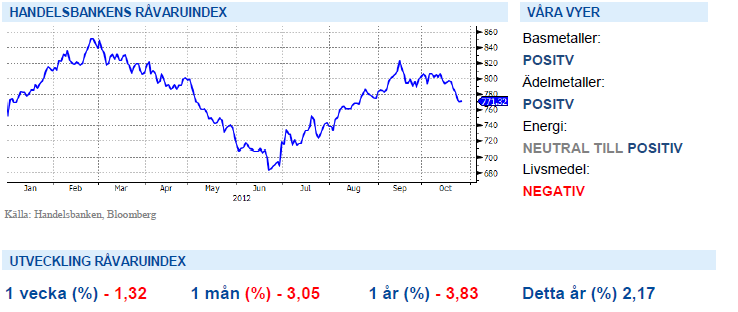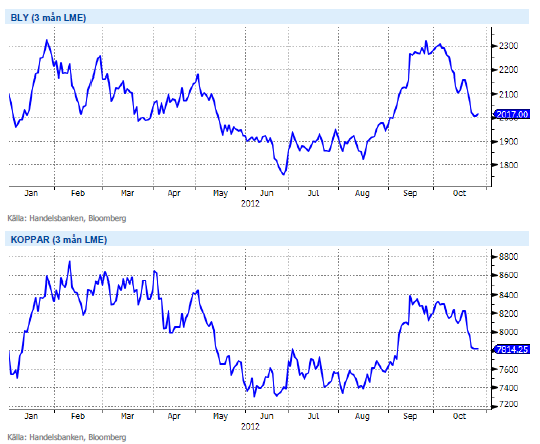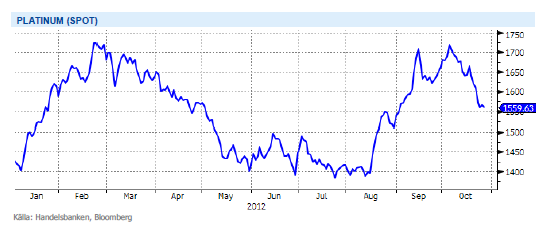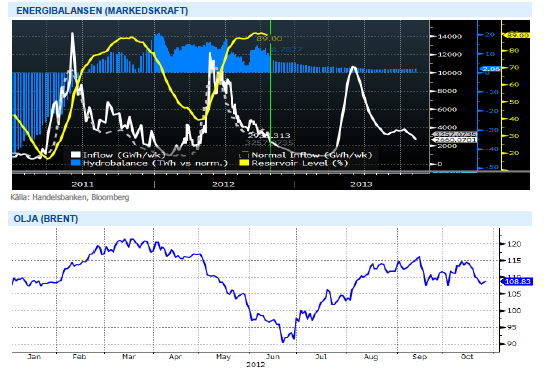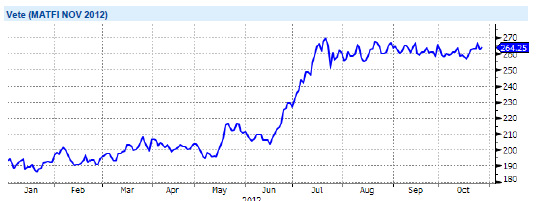Analys
SHB Råvarubrevet 26 oktober 2012
 Bättre data från Kina gläder
Bättre data från Kina gläder
Det senaste rallyt i råvaror har främst skett i bas- och ädelmetaller. Den sista raketen var Kinas infrastrukturpaket den 7e september och QE3 i USA den 14e september. Därefter har åter oro för Europas skuldkris och sämre än väntat bolagsrapporter för Q3 tyngt marknaden. Dåliga nyheter har fört tillbaka metallerna till samma nivåer som före Kinas infrastrukturprogram. Så i princip hela QE3 effekten är nu utraderad.
Under de två senaste veckorna har dock data från Kina varit bra. Industriproduktionen har vänt upp, likaså huspriserna och försäljningen i konsumentledet. Investeringarna ökar återigen och HSBC:s preliminära inköpschefsindex för oktober visade på en ökning i onsdags. Vi tror därför att de senaste nedgångarna har gått för långt och att råvaror, men främst metaller åter kommer stiga under slutet av året. Nästa vecka (1:a nov kl 02.00) kommer Kinas officiella inköpschefsindex och vi tror att det är rimligt att indexet stiger upp över 50 som är gränsen för tillväxt i ekonomin. Ytterligare stöd kan också komma från USA:s inköpschefsindex som kommer samma dag som Kina men kl 15.00 svensk tid.
Efter en ny vecka med blandade makrosignaler är vi någonstans mellan neutrala till positiva till risksentimentet. Riskrallyt drivet av QE3 förstärker makro, speciellt i USA men förväntningarna på den globala återhämningen har skruvats ner de senaste veckorna, kanske för mycket och det finns möjlighet till positiva överraskningar i närtid. Vi tror att valet i USA och ledarskiftet i Kina plus rapport säsongen håller uppe riskviljan de kommande veckorna. Valet i USA tar bort fiscal cliff diskussionen ur fokus vilket är positivt för riskviljan.
Basmetallerna har åter vänt uppåt efter sitt fall på 6,5 % från toppen i september, vi byter därför fot från neutral till något positivare igen. Råoljan fortsätter handlas i sitt intervall mellan 109 och 117 och vi tycker att fundamenta är väl balanserat och motiverar att vara neutral. Även el, som vi hoppas på inför vintern med nedpressade förväntningar ligger kvar i sitt intervall och vi väntar fortfarande på rätt köpläge. Håll dock el under bevakning, vintern närmar sig och därmed riskerna. El är volatil och när det vänder upp går det snabbt.
Basmetallerna
Basmetallerna – en besvikelse
För basmetallerna har veckan varit en besvikelse. Aluminium har klarat sig bäst, relativt sett, med en nedgång på 1.4 %. Bly fick däremot mer stryk, med en nedgång på hela 4.6 %. Koppar, zink och nickel har tappat mellan 2 och 4 %. Nedgången kan till viss del förklaras med en starkare dollar men även ett svagare risksentiment bidrog.
Ser vi specifikt till koppar så verkar nedgången mildrats av låga lagernivåer (de lägsta sedan april 2008) och en något ökad efterfrågan (upp 5.7% sedan augusti). Vi är fortsatt positiva till basmetaller eftersom vi ser förnyade investeringar från Kina samt en något bättre global konjunktur.
Efter en tid med fallande priser på basmetaller är vi åter positiva. Vi tror på: BASMET H
Ädelmetaller
Priset på platinum rasar
Guldet handlas i skrivande stund på 1714 USD/uns, vilket är marginellt lägre än veckans öppning. Platinum fortsätter sin väg ned, från toppnivån i början av oktober då platinum priset handlades på 1717 USD/uns har metallen tappat 9,3 % av sitt värde till 1559 USD/uns. Efter arbetarna vid platinumgruvan i Sydafrika har återvänt till arbete (efter en lönehöjning på hela 22 %) ser situationen på utbudssidan allt ljusare ut.
Däremot har guldgruvorna fortsatta problem och processen att avskeda 20 000 arbetare har startat. Gold Fields har avskedat 8 500 arbetare som inte återvänt från strejk trots ställt ultimatum och fler lär få samma besked vid andra guldgruvor om strejken fortsätter. Produktionsbortfallet på grund av strejkerna motsvarar nu 0,3 % av Sydafrikas BNP.
Vi fortsätter att se centralbankernas nytryckta pengar och framförallt Feds QE3 operation som starkt skäl att vara investerad i ädelmetallerna. Konflikterna i Sydafrika fortsätter och ger stöd åt och guldpriset. Vi tror på: ADELMET H
Energi
Priset på både olja och el faller
Oljepriset (Brent) föll i början av veckan men återhämtade sig något mot slutet och handlas under fredag eftermiddag på 109 USD/fat,vilket är 1 % lägre än samma tid förra veckan. Mindre risktagande i väntan på det amerikanska valet och höga spanska räntor tynger oljan. Översvämningar och infrastuktur sabotage i Nigeria ger dock stöd. Shell meddelade force majeure för export på ca 0,4 miljoner fat/ dag i oktober. Amerikansk lagerdata visar på lageruppbyggnad, lager på råoljan kom in på på 5,9 miljoner fat mot förväntade 1,9 miljoner fat.
Elmarknaden och kvartalskontraktet Q1 2013 backar närmare 3 procent till 41.35 euro under veckan till följd av ett väderomslag samtidigt som både kol och tyska elpriser försvagas. Om vi börjar med vädret så försvinner en del kylan i slutet av 10-dagarsprognosen och vi ser ut att få temperaturer på ca 2 grader under normalt (att jämföra med 5 grader kallare under normalt i början av veckan) samtidigt som vi förväntas få någon TWh nederbörd över normalt. Energibalansen borde således förbättras något till en ca +8TWh (se nedan). Kol och CO2 backar med 2 respektive 3 procent vilket gör att brytpriset för kol, dvs marginalen för kolgenererad kraft, landar strax under 37 euro vilket naturligtvis också tynger utvecklingen denna vecka. Bör finnas utrymme för ytterligare någon euro på nedsidan om den våta och varma avslutningen ligger kvar på väderprognoserna.
Oljan har sett allt svagare ut och vi fortsätter tycka att underliggande fundamenta är väl balanserad. El börjar se intressant ut inför vintern då riskerna på elmarknaden tilltar men vi låter sektorsynen vara neutral till positiv.
Livsmedel
Regn behövs i USA – inte i Europa
Terminspriser på vete är i stort sett oförändrade sedan förra veckan i både Chicago och Paris. Än behövs det mer regn på det nysådda höstvetet i USA, en del småskurar då och då lindrar dock situationen något. Även i Australien är det mestadels torrt för vetet, endast små regnmängder har fallit i de östra delarna av landet – längst i norr har skörden redan startat och avkastningsnivåerna sägs vara en klar besvikelse.
I Europa har det regnat lite väl mycket i de västra delarna, vilket fördröjer sådden i bland annat Frankrike och Storbritannien. I Frankrike är sådden nu bara klar till omkring 20 procent, att jämföra med 50 procent vid samma tid förra året – vilket lär leda till något mindre höstsådd areal. I Argentina är det fortfarande blött vilket försenar skördearbetet, bara omkring 4 procent av skörden bedöms nu vara klar. Helt klart kommer även kvalitetsnivån på vetet påverkas negativt av den blöta väderleken.
Väldigt mycket negativt är nu inprisat i dagens nivå och vi förväntar oss viss svårighet för priserna att nå så mycket högre. Långsiktigt är det svårt att se varför dagens nära rekordhöga priser ska hålla i sig – även om väldigt mycket kan hända till dess.
Vi ser soja, majs och vete som klara säljcase där vi väntar oss prisfall före jul men senast till påsk. Vi tror på: LIVSMEDEL S H
Handelsbankens Råvaruindex
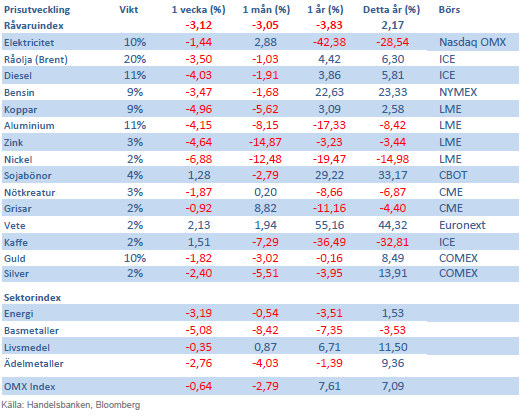
Handelsbankens råvaruindex består av de underliggande indexen för respektive råvara. Vikterna är bestämda till hälften från värdet av global produktion och till hälften från likviditeten i terminskontrakten.
[box]SHB Råvarubrevet är producerat av Handelsbanken och publiceras i samarbete och med tillstånd på Råvarumarknaden.se[/box]
Ansvarsbegränsning
Detta material är producerat av Svenska Handelsbanken AB (publ) i fortsättningen kallad Handelsbanken. De som arbetar med innehållet är inte analytiker och materialet är inte oberoende investeringsanalys. Innehållet är uteslutande avsett för kunder i Sverige. Syftet är att ge en allmän information till Handelsbankens kunder och utgör inte ett personligt investeringsråd eller en personlig rekommendation. Informationen ska inte ensamt utgöra underlag för investeringsbeslut. Kunder bör inhämta råd från sina rådgivare och basera sina investeringsbeslut utifrån egen erfarenhet.
Informationen i materialet kan ändras och också avvika från de åsikter som uttrycks i oberoende investeringsanalyser från Handelsbanken. Informationen grundar sig på allmänt tillgänglig information och är hämtad från källor som bedöms som tillförlitliga, men riktigheten kan inte garanteras och informationen kan vara ofullständig eller nedkortad. Ingen del av förslaget får reproduceras eller distribueras till någon annan person utan att Handelsbanken dessförinnan lämnat sitt skriftliga medgivande. Handelsbanken ansvarar inte för att materialet används på ett sätt som strider mot förbudet mot vidarebefordran eller offentliggörs i strid med bankens regler.
Analys
Brent crude set to dip its feet into the high $50ies/b this week

Parts of the Brent crude curve dipping into the high $50ies/b. Brent crude fell 2.3% over the week to Friday. It closed the week at $61.29/b, a slight gain on the day, but also traded to a low of $60.14/b that same day and just barely avoided trading into the $50ies/b. This morning it is risk-on in equities which seems to help industrial metals a little higher. But no such luck for oil. It is down 0.8% at $60.8/b. This week looks set for Brent crude to dip its feet in the $50ies/b. The Brent 3mth contract actually traded into the high $50ies/b on Friday.

The front-end backwardation has been on a weakening foot and is now about to fully disappear. The lowest point of the crude oil curve has also moved steadily lower and lower and its discount to the 5yr contract is now $6.8/b. A solid contango. The Brent 3mth contract did actually dip into the $50ies/b intraday on Friday when it traded to a low point of $59.93/b.
More weakness to come as lots of oil at sea comes to ports. Mid-East OPEC countries have boosted exports along with lower post summer consumption and higher production. The result is highly visibly in oil at sea which increased by 17 mb to 1,311 mb over the week to Sunday. Up 185 mb since mid-August. On its way to discharge at a port somewhere over the coming month or two.
Don’t forget that the oil market path ahead is all down to OPEC+. Remember that what is playing out in the oil market now is all by design by OPEC+. The group has decided that the unwind of the voluntary cuts is what it wants to do. In a combination of meeting demand from consumers as well as taking back market share. But we need to remember that how this plays out going forward is all at the mercy of what OPEC+ decides to do. It will halt the unwinding at some point. It will revert to cuts instead of unwind at some point.
A few months with Brent at $55/b and 40-50 US shale oil rigs kicked out may be what is needed. We think OPEC+ needs to see the exit of another 40-50 drilling rigs in the US shale oil patches to set US shale oil production on a path to of a 1 mb/d year on year decline Dec-25 to Dec-26. We are not there yet. But a 2-3 months period with Brent crude averaging $55/b would probably do it.
Oil on water increased 17 mb over the week to Sunday while oil in transit increased by 23 mb. So less oil was standing still. More was moving.

Crude oil floating storage (stationary more than 7 days). Down 11 mb over week to Sunday

The lowest point of the Brent crude oil curve versus the 5yr contract. Weakest so far this year.

Crude oil 1mth to 3mth time-spreads. Dubai held out strongly through summer, but then that center of strength fell apart in late September and has been leading weakness in crude curves lower since then.

Analys
Crude oil soon coming to a port near you

Rebounding along with most markets. But concerns over solidity of Gaza peace may also contribute. Brent crude fell 0.8% yesterday to $61.91/b and its lowest close since May this year. This morning it is bouncing up 0.9% to $62.5/b along with a softer USD amid positive sentiment with both equities and industrial metals moving higher. Concerns that the peace in Gaza may be less solid than what one might hope for also yields some support to Brent. Bets on tech stocks are rebounding, defying fears of trade war. Money moving back into markets. Gold continues upwards its strong trend and a softer dollar helps it higher today as well.

US crude & products probably rose 5.6 mb last week (API) versus a normal seasonal decline of 2.4 mb. The US API last night partial and thus indicative data for US oil inventories. Their data indicates that US crude stocks rose 7.4 mb last week, gasoline stocks rose 3.0 mb while Distillate stocks fell 4.8 mb. Altogether an increase in commercial crude and product stocks of 5.6 mb. Commercial US crude and product stocks normally decline by 2.4 mb this time of year. So seasonally adjusted the US inventories rose 8 mb last week according to the indicative numbers by the API. That is a lot. Also, the counter seasonal trend of rising stocks versus normally declining stocks this time of year looks on a solid pace of continuation. If the API is correct then total US crude and product stocks would stand 41 mb higher than one year ago and 6 mb higher than the 2015-19 average. And if we combine this with our knowledge of a sharp increase in production and exports by OPEC(+) and a large increase in oil at sea, then the current trend in US oil inventories looks set to continue. So higher stocks and lower crude oil prices until OPEC(+) switch to cuts. Actual US oil inventory data today at 18:00 CET.
US commercial crude and product stocks rising to 1293 mb in week 41 if last nights indicative numbers from API are correct.

Crude oil soon coming to a port near you. OPEC has lifted production sharply higher this autumn. At the same time demand for oil in the Middle-East has fallen as we have moved out of summer heat and crude oil burn for power for air-conditioning. The Middle-East oil producers have thus been able to lift exports higher on both accounts. Crude oil and condensates on water has shot up by 177 mb since mid-August. This oil is now on its way to ports around the world. And when they arrive, it will likely help to lift stocks onshore higher. That is probably when we will lose the last bit of front-end backwardation the the crude oil curves. That will help to drive the front-month Brent crude oil price down to the $60/b line and revisit the high $50ies/b. Then the eyes will be all back on OPEC+ when they meet in early November and then again in early December.
Crude oil and condensates at sea have moved straight up by 177 mb since mid-August as OPEC(+) has produced more, consumed less and exported more.

Analys
The Mid-East anchor dragging crude oil lower

When it starts to move lower it moves rather quickly. Gaza, China, IEA. Brent crude is down 2.1% today to $62/b after having traded as high as $66.58/b last Thursday and above $70/b in late September. The sell-off follows the truce/peace in Gaze, a flareup in US-China trade and yet another bearish oil outlook from the IEA.

A lasting peace in Gaze could drive crude oil at sea to onshore stocks. A lasting peace in Gaza would probably calm down the Houthis and thus allow more normal shipments of crude oil to sail through the Suez Canal, the Red Sea and out through the Bab-el-Mandeb Strait. Crude oil at sea has risen from 48 mb in April to now 91 mb versus a pre-Covid normal of about 50-60 mb. The rise to 91 mb is probably the result of crude sailing around Africa to be shot to pieces by the Houthis. If sailings were to normalize through the Suez Canal, then it could free up some 40 mb in transit at sea moving onshore into stocks.
The US-China trade conflict is of course bearish for demand if it continues.
Bearish IEA yet again. Getting closer to 2026. Credibility rises. We expect OPEC to cut end of 2025. The bearish monthly report from the IEA is what it is, but the closer we get to 2026, the more likely the IEA is of being ball-park right in its outlook. In its monthly report today the IEA estimates that the need for crude oil from OPEC in 2026 will be 25.4 mb/d versus production by the group in September of 29.1 mb/d. The group thus needs to do some serious cutting at the end of 2025 if it wants to keep the market balanced and avoid inventories from skyrocketing. Given that IEA is correct that is. We do however expect OPEC to implement cuts to avoid a large increase in inventories in Q1-26. The group will probably revert to cuts either at its early December meeting when they discuss production for January or in early January when they discuss production for February. The oil price will likely head yet lower until the group reverts to cuts.
Dubai: The Mid-East anchor dragging crude oil lower. Surplus emerging in Mid-East pricing. Crude oil prices held surprisingly strong all through the summer. A sign and a key source of that strength came from the strength in the front-end backwardation of the Dubai crude oil curve. It held out strong from mid-June and all until late September with an average 1-3mth time-spread premium of $1.8/b from mid-June to end of September. The 1-3mth time-spreads for Brent and WTI however were in steady deterioration from late June while their flat prices probably were held up by the strength coming from the Persian Gulf. Then in late September the strength in the Dubai curve suddenly collapsed. Since the start of October it has been weaker than both the Brent and the WTI curves. The Dubai 1-3mth time-spread now only stands at $0.25/b. The Middle East is now exporting more as it is producing more and also consuming less following elevated summer crude burn for power (Aircon) etc.
The only bear-element missing is a sudden and solid rise in OECD stocks. The only thing that is missing for the bear-case everyone have been waiting for is a solid, visible rise in OECD stocks in general and US oil stocks specifically. So watch out for US API indications tomorrow and official US oil inventories on Thursday.
No sign of any kind of fire-sale of oil from Saudi Arabia yet. To what we can see, Saudi Arabia is not at all struggling to sell its oil. It only lowered its Official Selling Prices (OSPs) to Asia marginally for November. A surplus market + Saudi determination to sell its oil to the market would normally lead to a sharp lowering of Saudi OSPs to Asia. Not yet at least and not for November.
The 5yr contract close to fixed at $68/b. Of importance with respect to how far down oil can/will go. When the oil market moves into a surplus then the spot price starts to trade in a large discount to the 5yr contract. Typically $10-15/b below the 5yr contract on average in bear-years (2009, 2015, 2016, 2020). But the 5yr contract is usually pulled lower as well thus making this approach a moving target. But the 5yr contract price has now been rock solidly been pegged to $68/b since 2022. And in the 2022 bull-year (Brent spot average $99/b), the 5yr contract only went to $72/b on average. If we assume that the same goes for the downside and that 2026 is a bear-year then the 5yr goes to $64/b while the spot is trading at a $10-15/b discount to that. That would imply an average spot price next year of $49-54/b. But that is if OPEC doesn’t revert to cuts and instead keeps production flowing. We think OPEC(+) will trim/cut production as needed into 2026 to prevent a huge build-up in global oil stocks and a crash in prices. But for now we are still heading lower. Into the $50ies/b.
-

 Nyheter4 veckor sedan
Nyheter4 veckor sedanOPEC+ missar produktionsmål, stöder oljepriserna
-

 Nyheter2 veckor sedan
Nyheter2 veckor sedanGoldman Sachs höjer prognosen för guld, tror priset når 4900 USD
-

 Nyheter3 veckor sedan
Nyheter3 veckor sedanBlykalla och amerikanska Oklo inleder ett samarbete
-

 Nyheter3 veckor sedan
Nyheter3 veckor sedanGuld nära 4000 USD och silver 50 USD, därför kan de fortsätta stiga
-

 Analys4 veckor sedan
Analys4 veckor sedanAre Ukraine’s attacks on Russian energy infrastructure working?
-

 Nyheter2 veckor sedan
Nyheter2 veckor sedanLeading Edge Materials är på rätt plats i rätt tid
-

 Nyheter3 veckor sedan
Nyheter3 veckor sedanEtt samtal om guld, olja, koppar och stål
-

 Nyheter2 veckor sedan
Nyheter2 veckor sedanNytt prisrekord, guld stiger över 4000 USD


